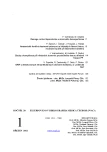Open reduction and internal fixation in dislocated intraarticular calcanear fractures, 2. – practical part
Authors:
Vladimír Popelka; Radoslav Zamborský; Peter Dečo; Peter Šimko
Authors‘ workplace:
Department of trauma surgery, University Hospital in Bratislava - Kramare
; Klinika úrazovej chirurgie, FN Bratislava-Kramáre
Published in:
Úraz chir. 20., 2012, č.1
Overview
The study objectives:
For its complex morphology calcaneus is one of the most complicated bones in human body. Anatomic restoration of its shape is often difficult, mostly in intraarticular fractures. When it's healed in malposition it can lead to serious permanent consequences with significant limitation in everyday life.
The aim of this prospective study was to verify the correctness of plate osteosynthesis indication in intraarticular heel fractures following the treatment algorithm at our department.
Material:
During the 5year period (3/2006 3/2011) we have performed surgical treatment in 59 patients (45 men76 %, 14 female24 %) at the Department of Trauma Surgery in University Hospital BratislavaKramáre. We have recorded 12 cases (24 %) of bilateral calcanear fractures, therefore the total number of surgically treated intraarticular fractures was 71. According to current classifications we have recorded 39 Sanders type II fractures (50 %), 23 Sanders type III fractures (32 %) and 9 Sanders type IV fractures (13 %).
Methods:
We have performed plate osteosynthesis in 46 cases of the total number 71 fractures (64,5 %). Calcanear plate was used in 22 fractures of Sanders II depression type (31 %), also in all 23 fractures of type Sanders III (32 %) and in one case with fracture type Sanders IV (1,5 %). Indication criteria were strictly followed in all cases where the ORIF was performed. Authors have selected extended lateral approach (Seattle) in 44 cases and medial approach (Mc Raynolds) in two cases. The average admission to surgical intervention time was 8,2 days.
Results:
The average follow up period was 6 to 36 months. Two scoring systems (CreightonNebraska Health Foundation Assessment score and Ankle Hindfoot AOFAS scale) were used to evaluate limb function. In the group of 46 patients with ORIF we have achieved excellent result in 26 cases (56,5 %) and good results in 9 cases (9,5 %). In 8 cases (17,5 %) the results were only satisfactory and 3 cases (6,5 %) were evaluated as poor. We have recorded 3 wound healing complications (6,5 %) where a marginal skin necrosis was present. Postoperative algodystrophic syndrome was present in one case (2,2 %).
Conclusion:
Open reduction and internal fixation using calcanear plate is a reliable surgical treatment in Sanders II depression type and Sanders III intraarticular fractures.
Key words:
ORIF open reduction and internal fixation, surgical approaches.
Sources
1. BAJAMMAL, S., TORNETTA, P., SANDERS, et al. Displaced intraarticular calcaneal fractures, J Orthop Trauma. 2005, 19, 360–364.
2. BERNIRSCHKE, S. K., SANGEORSEAN, B. J. Extensive intraarticular fractures of the foot. Surgical management of calcaneal fractures. Clin Orthop. 1993, 292, 128–141.
3. BUCKLEY, R. E. Evidence for the Best Treatment for Displaced Intraarticular Calcaneal Fractures. Acta chir orthop Traumatol čech. 2010, 77, 179–185.
4. EASTWOOD, D. M., GREGG, P. J., ATKINS, R. M. Intraarticular fractures of the calcaneum, Part II, Open reduction and internal fixation by the extended lateral transcalcaneal approach. J Bone Joint Surg. 1993, 75B2, 189–195.
5. ESSEXLOPRESTI, P. The mechanism, reduction technique, and results in fractures of the os calcis. Br J Surg. 1952, 39, 395–419.
6. HEGER, T., ŠIMKO, P., GRAUZEL, J., POPELKA, V. Ako správne ošetrovať zlomeniny pätovej kosti. Lek Obz. 2007, 56, 331–337.
7. KITAOKA, H. B., ALEXANDER, I. J., ADAALAR, R. S. et al. Clinical rating system for the ankle, hindfoot, midfoot, hallux and leaser toes. Foot ankle Int. 1994, 15, 349–353.
8. KOČIŠ, J., STOKLAS, J., KALANDRA, S. et al. Nitrokloubní zlomeniny patní kosti. Acta chir orthop Traumatol čech. 2006, 73, 164–168.
9. MC REYNOLDS, J. S. Open reduction and internal fixation of calcaneal fractures. J Bone Joint Surg Br. 1972, 54, 176–177.
10. PALMER, I. The mechanism and treatment of fractures of the calcaneus. Open reduction with the use cancelous grafts. J Bone Point Surg (Am). 1948, 30, 2–8.
11. POPELKA.V., ŠIMKO, P. Operačná liečba intraartikulárnych zlomenín pätovej kosti, Acta chir orthop Traumatolog čech. 2011, 76, 106–119.
12. POPELKA,V., ZAMBORSKÝ R., SCHMIDT P, ŠIMKO P. Otvorená repozícia a interná fixácia u dislokovaných intraartikulárnych zlomenín kalkanea Teoretická časť. Úraz chir. 2011, 19, 17–23.
13. RAK, V., IRA, D., MAŠEK, M. Operative treatment of intraarticular calcaneal fractures with calcaneal plates and its complications, Indian. J Orthop. 2009, 43, 271–280.
14. STEPHENSON, J. R. Treatment of displaced intraarticular fractures of the calcaneus using medial and lateral approaches, internal fixation, and early morión. J Bone Joint Surg Am. 1987, 69, 115–130.
15. SANDERS, R., FORTIN, P., DIPASCALE, A. Operative treatment in 120 displaced intraarticular calcaneal fractures, Result using a prognostic computed tomographic scan clasification. Clin Orthop. 1993, 290, 87–95.
16. STEHLÍK, J., ŠTULÍK, J. Zlomeniny patní kosti. Galén, 2005.
17. ZWIPP, H., RAMMELT, S., BARTHEL, S. Calcaneus fractures open reduction and internal fixation (ORIF). Injury Int J Care injured. 2004, 35, 46–54.
Labels
Surgery Traumatology Trauma surgeryArticle was published in
Trauma Surgery

2012 Issue 1
Most read in this issue
- Open reduction and internal fixation in dislocated intraarticular calcanear fractures, 2. – practical part
- Mistakes and complication of intramedullary nailing of proximal femur fractures using nail TARGON PF
- Extensor and deep flexor muscles of the calf anatomical and functional properties, possibility of using in tendon transfer
- Damage control laparotomy in trauma hemoperitoneum
